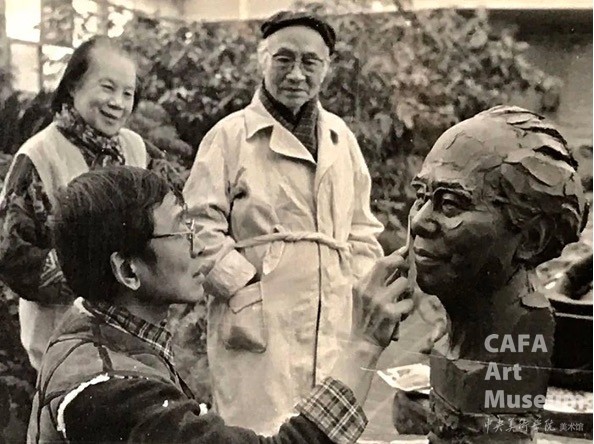
Situ Zhaoguang was born on June 10, 1940 in a Chinese family in Hong Kong. His family was originally from Kaiping City in Guangdong Province. He enrolled in the Affiliated Middle School of Central Academy of Fine Arts in 1955, and studied at the Department of Sculpture in CAFA from 1959. He was sent to Leningrad, the Soviet Union (now St. Petersburg, Russia) in 1961, and studied from Professor Mikhail Anikushin.

In 1966, Situ Zhaoguang came back to China, and began to teach at the Department of Sculpture in CAFA. His signature teaching style was making works together with his students, and demonstrating with his own hands. He attached importance to cultivating the students’ sense of space, and insisted that they "observe subjects stereoscopically", "with true love towards everything that’s beautiful". Being a teacher for decades, Situ Zhaoguang had always been educating young students whole-heartedly, and devoting himself to training the new generation of sculpture artists. He had always been a perfectionist in teaching work, winning respects from his students with his modest character, generous heart and brave style.

Students were touring around sculptor Konionkov’s studio. From left to right: Feng Zhen, Cao Chunsheng, Konionkov, Situ Zhaoguang, Zhang Huaqing, Wang Keqing, Su Gaoli

Situ Zhaoguang returned to China from the Soviet Union in 1966, and created the sculpture of Mao Zedong for the Beijing Institute of Technology.

Situ Zhaoguang was working at the sculpture studio in CAFA in 1984-85.

Situ Zhaoguang demonstrated painting methods for his students.
In the spring of 1974, Situ Zhaoguang was commissioned by the Ministry of Culture to go to Tibet with other sculptors from the CAFA Department of Sculpture, including Wang Keqing, Cao Chunsheng, Zhao Ruiying, Zhang Dedi, Zhang Dehua, Shi Yi, Guan Jing, Hao Jingping, Li Deli, and created the large-scale clay sculpture Anger of Serfs. In 1978, Situ was again sent to Tibet by the National Ethnic Affairs Committee, to collect materials and prepare for the replication of Anger of Serfs in the Cultural Palace of Nationalities in Beijing. He painted a great number of sketches of the Tibetan’s life and portraits during that time.

Group photo taken in 1976 show sculptors including Wang Keqing, Cao Chunsheng, Zhang Dedi, Zhang Dehua, Situ Zhaoguang, Guan Jing, Zhao Ruiying, He Jingping, Shi Yi, Li Deli, Duo Jila, Yang Weiming, Ali, Guo Linxin, Tu Sihua, and the then director of Tibet Revolution Exhibition Hall Xue Yilou, and consultant Zhol Khang Thub Bstan Nyi Ma.

Situ Zhaoguang engaged field work in Tibet in 1974-75.

Situ Zhaoguang revisited Tibet in 1978.
One of the pioneers of the new China’s urban sculpture, Situ Zhaoguang and his peers who also advocated for building sculpture in urban space went to cities like Moscow and Leningrad to study their sculpture. After he returned China, he created masterpieces such as Reading, Revery and Bursting, which are seen as the highlights of urban sculpture in China. Situ also had clear observation of the urban sculpture at his time. He put forward the idea of "Better less than poor-quality", which was also a reflection of his creative attitude.

Every morning in 1984, Situ Zhaoguang went to the garden on Zhengyi Road to make the sculpture Reading, attracting many passers-by to stop to watch.
In 1997, after toilsome hard work, Situ Zhaoguang fell ill, and was diagnosed Parkinson’s disease. Although suffering from chronic illness, he still carried on creating sculpture for famous people such as He Xiangning, Sun Zhongshan, Wu Zuoren and Liang Sicheng. Situ Zhaoguang had always portrayed his subjects serious-mindedly, and never found it a bother to repeatedly polish his work. The sculpture he made of famous people were as timeless as those people’s biographies, with essence of life flowing beneath the stiff surface of stones and rocks.

Situ Zhaoguang made a sculpture of Rene Wang.

Situ Zhaoguang was making a sculpture of Wu Zuoren, while Mr. Wu and his wife Xiao Shufang watched the process behind him.

Situ Zhaoguang made a sculpture of Liang Sicheng despite of his illness.
Situ Zhaoguang had always observed the world with simple and pure eyes, and captured the inner beauty of the subjects with passion. He sculpted liveliness into stones and woods, along with the aura of the subjects and his loving care for the subjects, so that the subjects live forever in the sculpture. The beauty of his creativity not only existed in his work, but also wrote a great paragraph for the splendid era of the new China.


2021-12-06

2021-12-07

